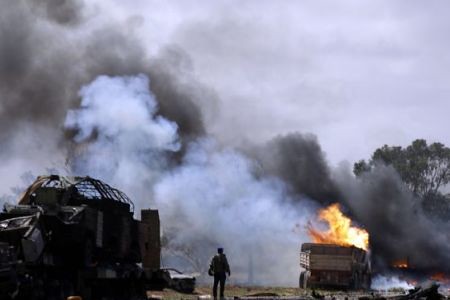
US imperialism and its allies are bombing North Africa everyday in an effort to destroy the oil-producing state of Libya., a photo by Pan-African News Wire File Photos on Flickr.
Pentagon Says It Has Kept Up Some Strikes on Libya
By THOM SHANKER
New York Times
WASHINGTON — Pentagon officials disclosed Wednesday that American warplanes had continued to strike targets in Libya even after the Obama administration said the United States was stepping back from offensive missions and letting NATO take the lead.
Although American officials had said that no aircraft would fly offensive strike missions, unless officially approved in Washington, 11 warplanes have flown 97 sorties intended to electronically jam or otherwise suppress Libyan air defenses since April 4, when command of the mission was handed over to NATO and the United States publicly said it was stepping back to a supporting role.
The number of actual missile strikes during those missions was only three; all were against Libyan air defense systems, whether radars, command-and-control sites or surface-to-air missiles. Two of them were to destroy hard-to-find and hard-to-strike mobile targets.
In explaining the gap between public statements and operational details, officials said the trio of strikes on Libyan targets since April 4 were classified as defensive, not offensive.
The distinction was that these attacks were intended to incapacitate Libyan radars, antiaircraft batteries or command centers in order to protect NATO strike aircraft, and were not offensive actions against Libyan government forces threatening civilians.
Pentagon officials had to scramble Wednesday to explain the latest nuance about the American mission in Libya.
The administration has expended enormous effort calibrating its explanation of the intervention there to a variety of audiences: the American public, Libyans still loyal to the government or rebel sympathizers, and people in Europe and the Arab world.
At a minimum, the disclosure of strikes dating back several days — on April 4, 6 and 7 — revealed a tin ear for how the facts of daily combat operations would compare to public statements that left the impression that the United States had ceased dropping bombs and missiles on Libya.
The continued operation of American warships and warplanes in both supporting and attacking roles is evidence that, while NATO is in command, the United States military remains the partner with specific capabilities that are required for the alliance to operate effectively.
American officials had said that only support aircraft — like refueling, reconnaissance and command-and-control planes — would be part of the daily operation. Any NATO desire for American strike aircraft, in particular the A-10 tank-buster and the AC-130 flying gunship — would have to be requested formally and approved in Washington.
But the 11 American warplanes assigned to a mission called Suppression of Enemy Air Defense are flying as part of the NATO-led mission.
“It is a purely defensive mission,” the Pentagon said in an official statement. Later, the Pentagon press secretary, Geoff Morrell, added, “It is completely consistent with how we have described our support role ever since the transition to NATO lead.”
The American aircraft assigned to suppressing Libyan air defenses are six F-16CJ aircraft and five E/A-18G warplanes, according to Pentagon officials. Working together, they can detect and jam adversary air defense systems and attack them with missiles, some specifically designed to home in on radar emissions.
The disclosure came one day after fissures opened among the allies over the scope and the intensity of attacks against Libyan government forces. Britain and France, in particular, called on NATO and its partners to intensify strikes.
The Pentagon on Wednesday released a full tally of all the American military ships and aircraft participating in the Libyan mission: one guided-missile destroyer; one P-3C Orion maritime patrol aircraft; one EP-3E signals reconnaissance aircraft; 22 KC-135 tankers; six F-16CJ aircraft; five EA-18G attack aircraft; two E-3 command and control aircraft; two EC-130 signals and communications aircraft; two RC-135 reconnaissance aircraft; one U-2 high-altitude reconnaissance aircraft; one E-8 Joint Surveillance Target Attack Radar System; two MQ-1 Predator unmanned aerial vehicles; and one RQ-4 Global Hawk unmanned aerial vehicle.
No comments:
Post a Comment